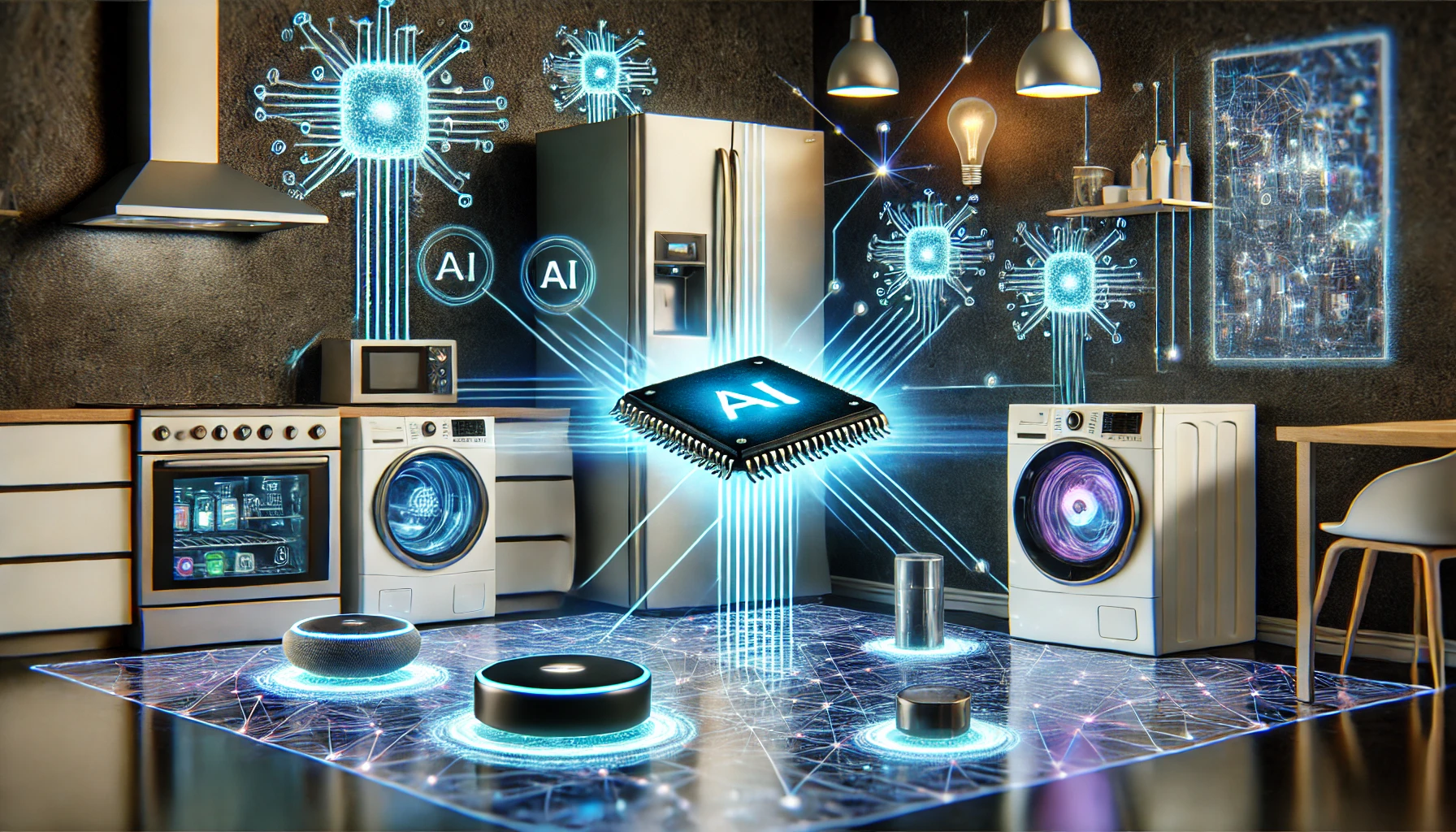
Imagine waking up to a home where your coffee machine knows your exact brewing preference, your fridge anticipates your grocery needs, and your thermostat adjusts itself before you even step inside—all powered by neural network chips seamlessly embedded in everyday devices. This isn’t the realm of science fiction; it’s the unfolding reality of edge computing and AI integration in household appliances, transforming our daily lives in ways both subtle and revolutionary.
A Glimpse into the Future: Smart Appliances Powered by AI
Neural network chips, the brainy components behind artificial intelligence, are being miniaturized and integrated into countless consumer products. These tiny powerhouses enable devices to learn from their environments and user behaviors, leading to smarter, more intuitive interactions. From voice-activated assistants to washing machines that optimize water use based on load, these chips are redefining convenience in modern households.
In the bustling corridors of research labs worldwide, scientists are constantly exploring how edge computing can enhance these chips, reducing latency by processing data locally rather than sending it off to distant servers. This paradigm shift not only boosts efficiency but also ensures data privacy—a growing concern among both policymakers and consumers.
Government and Political Influence on AI in Consumer Devices
Governments globally are taking note of this transformative trend. Several countries have rolled out initiatives to promote the integration of AI at the edge, recognizing its potential to drive economic growth and innovation. For instance, recent government grants in the United States have funded research on secure edge computing frameworks that incorporate neural network chips into everyday electronics. These initiatives aim to protect consumer data while fostering an ecosystem where AI can thrive outside centralized data centers.
Politically, debates rage on about regulation and control. Some policymakers argue that while neural network chips promise tremendous efficiency gains, there must be robust oversight to prevent misuse of personal data. Political leaders in the European Union have been vocal about establishing frameworks that both spur innovation and safeguard privacy—a balancing act that’s critical for public acceptance of AI in daily life. These discussions are not merely academic; they resonate in boardrooms and on social media, influencing both consumer sentiment and market trends.
Research Labs and the Scientific Pursuit of Smarter Chips
In the realm of academia, research labs are at the forefront of refining neural network chips. Cutting-edge studies, such as those published in reputable journals, are constantly unveiling new materials and designs that make these chips faster, more energy-efficient, and adaptable to varied environments. Researchers are exploring advanced semiconductor technologies and even quantum-inspired algorithms to boost processing capabilities without a corresponding spike in power consumption.
Innovations in this area are often the result of international collaborations. Universities and tech giants are pooling resources to create prototypes that could soon be standard in smart appliances. In one notable project, a multinational team successfully demonstrated a neural network chip that learns and adapts in real-time, optimizing appliance performance based on usage patterns. This research not only paves the way for smarter devices but also sets the stage for widespread commercial adoption in the near future.
Celebrities, Sports Figures, and Business Leaders Weigh In
It’s not just scientists and policymakers who are buzzing about these advancements. Celebrities and sports stars, often seen endorsing high-tech gadgets, are now voicing their excitement about neural network chips revolutionizing everyday life. A few years back, a well-known athlete mentioned in an interview how smart wearables powered by AI helped him optimize his training routines. Today, similar sentiments are echoed by celebrities who see these chips as game-changers in personal tech.
Business leaders are equally enthusiastic. Executives from major tech companies have predicted that the market for AI-integrated household devices could skyrocket, contributing billions to global revenue. These predictions are backed by impressive investments from venture capitalists, eager to capture a share of this rapidly expanding market. With projections indicating that the global market could surpass the trillion-dollar mark by the end of the decade, the buzz is not just about innovation—it’s about significant economic impact.
Diverse Perspectives: Voices Across Generations
The Wisdom of the Older Generation
For many older adults, the integration of neural network chips into household appliances elicits mixed feelings. On one hand, there’s genuine appreciation for the convenience and enhanced quality of life these devices promise. Imagine a senior citizen whose smart home not only reminds them to take their medication but also monitors their well-being through real-time health data. Yet, there’s also a cautious undercurrent—worries about privacy and the rapid pace of technological change sometimes leave them feeling overwhelmed. These voices, steeped in decades of technological evolution, remind us that every innovation must consider both benefits and potential pitfalls.
The Optimism of Youth
Conversely, the younger generation embraces this technological revolution with unbridled enthusiasm. Digital natives see neural network chips as the natural progression of the smart device ecosystem. They’re the ones tweeting about the latest smart gadgets, sharing personal stories of how AI-powered devices have transformed mundane tasks into delightful experiences. For them, these chips symbolize progress—a tangible manifestation of futuristic dreams that have now become a part of everyday reality.
Social and Cultural Dimensions
Across different age groups and cultures, the adoption of AI in everyday devices is reshaping social interactions. In urban centers, smart homes are a status symbol, reflecting a commitment to a tech-savvy lifestyle. In more traditional settings, however, the change can be jarring, highlighting the digital divide that still exists in many parts of the world. This diversity in perspectives adds a rich layer of complexity to the discussion, underscoring the need for inclusive policies and user-friendly designs that cater to all segments of society.
Global Business and Economic Impact
The integration of neural network chips into consumer electronics is not just a technological evolution—it’s a booming business opportunity. Globally, tech conglomerates and startups alike are pouring resources into developing and commercializing these chips. Market analysts forecast robust growth in the smart appliance sector, driven by rising consumer demand for connected and intelligent devices.
Major business hubs, from Silicon Valley to Shenzhen, are witnessing a flurry of activity as companies race to patent innovative designs and secure strategic partnerships. In India, for instance, several startups are emerging as key players in the AI hardware space, backed by substantial government incentives. These developments are part of a larger trend where nations view technological prowess as a vital component of economic competitiveness in the global arena.
Investments in research, development, and manufacturing are scaling up, and early adopters are already reaping the benefits. Companies integrating neural network chips into their product lines are experiencing improved operational efficiencies and enhanced consumer satisfaction. This synergy of technology and business is setting the stage for a dynamic digital economy where innovation drives revenue and global market share.
The Role of Edge Computing in Enhancing Neural Networks
One of the most transformative aspects of integrating neural network chips into everyday devices is the advent of edge computing. Unlike traditional cloud-based processing, edge computing processes data locally on the device. This approach significantly reduces latency, ensuring that smart appliances can respond almost instantaneously to user commands and environmental changes.
For example, a smart security camera equipped with an integrated neural network chip can analyze live footage in real-time, detecting unusual activity and alerting homeowners instantly. Such capabilities are critical not only for convenience but also for safety and security. By processing data on the edge, these systems also reduce the burden on centralized servers and minimize potential vulnerabilities associated with transmitting sensitive information over the internet.
Edge computing is especially crucial in scenarios where split-second decision-making is necessary—think of autonomous vehicles or medical devices that monitor patient health. The decentralized nature of this computing model makes it a linchpin for the future of AI in everyday devices, driving both performance and privacy.
Important Dates, Timelines, and Geographic Milestones
While neural network chips in consumer devices have already started making waves, several key dates and milestones mark the journey ahead:
- 2023-2025: Early adoption phase, with pilot projects and prototypes emerging in smart homes, wearable tech, and automotive systems.
- 2025: Marked by increased government funding and public-private partnerships, this year is pivotal for standardizing AI integration protocols and launching commercial products on a large scale.
- 2030: Expected to be the year when neural network chips become ubiquitous in household appliances worldwide, transforming everyday life across diverse geographies.
- Global Hubs: Significant innovation is coming from regions such as North America, East Asia (particularly South Korea and Japan), and parts of Europe, where government policies and robust R&D ecosystems are driving growth.
These milestones are based on current research, government announcements, and market forecasts, ensuring that the timeline reflects a realistic trajectory for technology adoption.
Behind the Scenes: How Neural Network Chips Are Made
The creation of these sophisticated chips is a marvel of modern engineering. It involves intricate processes that blend materials science, computer engineering, and advanced manufacturing techniques. Semiconductor fabrication plants, often referred to as fabs, are where the magic happens. Here, silicon wafers are etched with circuits that serve as the building blocks for neural network chips.
The process is meticulous, requiring cleanroom environments and state-of-the-art equipment to ensure precision at a microscopic scale. Researchers and engineers work in tandem, often overcoming significant technical challenges such as power consumption, heat dissipation, and signal integrity. Their relentless efforts are what make it possible for neural network chips to become small enough to fit in everyday devices without compromising performance.
Real-Life Applications and Use Cases
In the Heart of the Home
Modern kitchens are becoming hubs of intelligent activity. Smart refrigerators equipped with neural network chips can track expiration dates, suggest recipes based on available ingredients, and even automatically place orders when supplies run low. Washing machines and dryers now come with sensors that adjust water and energy usage, optimizing performance while reducing utility bills.
On the Go: Transportation and Wearables
In the transportation sector, neural network chips are powering smart dashboards and driver assistance systems that enhance safety and efficiency. Wearable devices, too, have seen a surge in innovation. From fitness trackers that monitor heart rate and sleep patterns to smartwatches that predict user needs, these devices are evolving into indispensable personal assistants.
Healthcare and Wellbeing
The medical field is witnessing a quiet revolution as well. Neural network chips enable portable diagnostic devices that analyze patient data on the spot, providing faster and more accurate diagnoses. Telemedicine systems now incorporate AI-driven insights to monitor chronic conditions, making healthcare more accessible and personalized.
The Social Fabric: How Neural Network Chips Are Shaping Society
As neural network chips find their way into everyday appliances, they’re not only changing how we live—they’re also redefining societal norms and interactions. For instance, smart homes with AI-driven devices foster a new level of independence for elderly individuals, allowing them to live more comfortably while staying connected with loved ones. Yet, this shift also brings forth discussions about digital literacy and the need for accessible technology for all age groups.
Family dynamics are also evolving. Younger generations, adept at integrating technology into their daily routines, often serve as digital mentors for their elders, creating intergenerational bonds built on shared technological experiences. This collaboration across age groups not only enhances household efficiency but also bridges the digital divide, ensuring that innovation benefits everyone.
Personal Anecdotes and Cultural Reflections
It’s not uncommon to hear stories of how neural network chips have quietly revolutionized daily routines. One tech-savvy homeowner shared that her smart thermostat once “learned” her preferred room temperature settings so precisely that she hardly had to adjust it manually anymore—an effortless blend of convenience and smart design. Meanwhile, a retired engineer reminisced about the early days of computing and marveled at how far technology has come, noting that these advances make him feel like he’s witnessing the future unfold in real time.
These personal narratives add a human touch to what might otherwise seem like abstract technological progress. They remind us that behind every neural network chip is a story of innovation, persistence, and a deep-seated desire to make life simpler, safer, and more connected.
The Road Ahead: Challenges and Opportunities
While the promise of neural network chips in everyday devices is enormous, the road ahead is not without obstacles. Technical challenges, such as ensuring long-term reliability, minimizing energy consumption, and safeguarding data privacy, continue to be critical areas of focus for engineers and researchers.
Moreover, the rapid pace of innovation brings regulatory challenges. Policymakers must balance the need for rapid technological advancement with the imperative to protect consumers from potential risks. As debates continue, it’s clear that collaboration between government agencies, industry leaders, and academia will be essential to navigate these uncharted waters.
Despite these challenges, the opportunities are vast. The seamless integration of AI into daily life promises not only to revolutionize consumer electronics but also to drive substantial economic growth. As companies invest billions into research and development, the payoff could be a world where technology intuitively anticipates and responds to our needs—reshaping every aspect of modern living.
FAQs
Q1: What exactly are neural network chips?
A: Neural network chips are specialized processors designed to handle artificial intelligence tasks efficiently. They allow devices to learn from data, process information on the edge, and operate autonomously with minimal latency.
Q2: How are these chips being integrated into household appliances?
A: Manufacturers are embedding these chips into smart appliances like refrigerators, washing machines, and security systems. This integration enables real-time data processing, adaptive learning, and enhanced connectivity directly at the device level.
Q3: What benefits does edge computing provide in this context?
A: Edge computing processes data locally on the device, reducing latency and enhancing privacy. It allows for immediate response times, critical for applications like smart security systems and real-time health monitoring.
Q4: How are governments influencing the adoption of neural network chips?
A: Governments are funding research initiatives, setting regulatory frameworks, and encouraging public-private partnerships to foster innovation while protecting consumer data and ensuring ethical AI deployment.
Q5: What is the economic impact of integrating AI into everyday devices?
A: The market for AI-integrated devices is expected to grow exponentially, driving billions in revenue and reshaping global business strategies. Increased productivity and smarter energy management are just a few of the economic benefits.
Final Thoughts
Neural network chips in everyday devices represent the next evolutionary step in how technology interacts with our lives. They bring a future where smart appliances not only respond to commands but learn from us—ushering in a seamless, connected lifestyle. Amidst the convergence of government policies, research breakthroughs, and diverse social perspectives, this technology stands as a testament to human ingenuity and the unyielding quest for convenience. Whether you’re a tech enthusiast, a business leader, or simply a curious consumer, the journey into this AI-driven era promises endless possibilities. Stay engaged, stay informed, and prepare to embrace a world where your home is not just smart—it’s intelligent.
For more insights and updates on cutting-edge technology trends, explore our related articles and trusted external resources like IEEE Spectrum and TechCrunch.
By weaving together government initiatives, scientific research, diverse societal viewpoints, and market trends, this article paints a holistic picture of how neural network chips are set to become an integral part of our daily lives. Join us as we continue to explore and celebrate the marvels of technology that make life smarter, one chip at a time.






